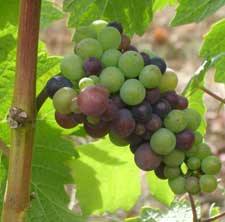Weighing the Cost of an Ounce of Prevention

The gnashing of teeth and pulling of hair began when a highly respected winemaker at a well-known winery tasted the very expensive Cabernet Sauvingon as it went to barrel.
“The wine had soap bubbles and smelled ‘fishy’,” said Jim Harbertson, author of a chapter in Winemaking Problems Solved entitled “My wine smells like old fish: what should I do?” Harbertson is an extension enologist based at WSU’s Irrigated Agriculture Research and Extension Center in Prosser.
“For the winemaker,” Harbertson said, “the question was, what should I do now? For me, as a WSU Extension educator, the question was, how do we prevent this from happening in the future?”
Winemakers typically forbid the use of what we think of as household cleaning agents. Agents containing bleach or soap can leave molecular traces that give wine an off taste and a very unappetizing smell. In particular, chlorinated sanitizers such as bleach have been forbidden because of their links to wine taints similar to cork taint, which is why filter manufactures have switched to alternative cleaning agents.
Upon investigation, Harbertson learned that the winemaking crew had filtered the wine using a recently acquired, high-tech piece of equipment. When the crew asked the manufacturer how the filter should be cleaned, the manufacturer recommended a substance which the crew duly employed.
“Unfortunately, the cleaning agent recommended by the filter manufacturer contained, basically, soap,” said Harbertson, sighing. “It was a tricky situation because the cleaner had been listed with proprietary ingredients but I was able to track them down. I try to impress upon people the importance of maintaining material safety data sheets for all of their winery chemicals in an easy-to-access database. Just because something comes from the filter manufacturer doesn’t mean it’s appropriate for use in a winery.”
In other words, trust no one. The filter manufacturer certainly should have known that the cleaning agent they were recommending contained soap — that they apparently didn’t, Harbertson stressed, is precisely the reason winemakers need to be conversant with the chemical composition of the substances they use in both making wine and cleaning up afterwards.
“Materials safety data sheets are all over the web,” he pointed out. “There’s really no excuse for not knowing, for not protecting your investment and the fruits of your labor.”
But what about that expensive barrel of Cabernet?
“Clearing the taint from the wine was the easy part,” said Harbertson. “We used milk fats to remove the molecules causing the bad smell. Of course, this affected the quality of the wine but at least they didn’t have to pour it down the drain.”
Get more information about Winemaking Problems Solved by visiting http://bit.ly/bnNq4N.
Late Ripening — and How to Deal

Acutely aware of the concern among both vineyard managers and winemakers about the consequences of a cool summer, WSU enologists Thomas Henick-Kling and Jim Harbertson have some tips to deal with late ripening.
“The delayed ripening we see in many Washington state vineyards poses some challenges,” write Henick-Kling and Harbertson in a just-pubolished newsletter. “With good will from Mother Nature, good work in the vineyard, and some extra efforts in the winery, this season should produce excellent wines. But we want to be prepared–just in case.
“The major problem will be logistics. It looks like we might have a very compressed grape harvest period with long working days and tight tank space. Of course, if Mother Nature gives us a beautiful long fall, all our fruit will ripen with intense flavors and good sugar and acid balance–and this letter will not have been necessary at all.
“The point of this discussion is to alert winemakers to expect ripe fruit flavors at lower sugar content and higher acidity. Since the majority of aroma compounds are found in grape skins, it is very important to taste the skins separate from the pulp and seeds. The difficulty is that most of the fruity aroma compounds in the grape are pre-cursors and are undetectable to human senses. However in varieties that are known to make vegetable aromas such as Sauvignon blanc, Cabernet Franc, Cabernet Sauvignon, Merlot, the skin can be used to determine how ripe the fruit is.”
Get the scoop on dealing with late ripening fruit by visiting http://bit.ly/aDvyKf.